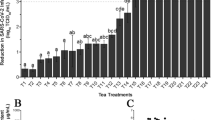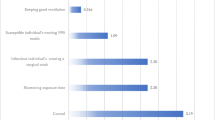Abstract
The purpose of this study was to validate the use of adenosine triphosphate (ATP) for evaluating hygiene intervention effectiveness in reducing viral dissemination in an office environment. The bacterial virus MS-2 was used to evaluate two scenarios, one where the hand of an individual was contaminated and another where a fomite was contaminated. MS-2 was selected as a model because its shape and size are similar to many human pathogenic viruses. Two separate experiments were conducted, one in which the entrance door push plate was inoculated and the other in which the hand of one selected employee was inoculated. In both scenarios, 54 selected surfaces in the office were tested to assess the dissemination of the virus within the office. Associated surface contamination was also measured employing an ATP meter. More than half of the tested hands and surfaces in the office were contaminated with MS-2 within 4 h. Next, an intervention was conducted, and each scenario was repeated. Half of the participating employees were provided hand sanitizer, facial tissues, and disinfecting wipes, and were instructed in their use. A significant (p < 0.05) reduction was observed in the number of surfaces contaminated with virus. This reduction in viral spread was evident from the results of both viral culture and the surface ATP measurements, although there was no direct correlation between ATP measurements with respect to viral concentration. Although ATP does not measure viruses, these results demonstrate that ATP measurements could be useful for evaluating the effectiveness of hygiene interventions aimed at preventing viral spread in the workplace.



Similar content being viewed by others
References
Aikin, Z. A., Wilson, M., & Pratten, J. (2011). Evaluation of ATP bioluminescence assays for potential use in a hospital setting. Infection Control and Hospital Epidemiology, 32, 507–509.
Anderson, R. L., Highsmith, A. K., & Holland, B. W. (1986). Comparison of the standard pour plate procedure and the ATP and limulus amebocyte lysate procedures for the detection of microbial contamination in intravenous fluids. Journal of Clinical Microbiology, 23, 465–468.
Aycicek, H., Oguz, U., & Karci, K. (2006). Comparison of results of ATP bioluminescence and traditional hygiene swabbing methods for the determination of surface cleanliness at a hospital kitchen. International Journal of Hygiene and Environmental Health, 209, 203–206.
Birbaum, H., Morley, M., Leong, S., & Colice, G. (2003). Lower respiratory tract infections: impact on the workplace. Pharmacoeconomics, 21, 749–759.
Bloomfield, S. F., Exner, M., Signorelli, C., Nath, K. J., & Scott E. A. (2016). The chain of infection transmission in the home and everyday life settings, and the role of hygiene in reducing the risk of infection. http://www.ifh-homehygiene.org/IntegratedCRD.nsf/111e68.
Boone, S. A., & Gerba, C. P. (2007). Significance of fomites in the spread of respiratory and enteric viral disease. Applied and Environmental Microbiology, 73, 1687–1696.
Boyce, J. M., Havell, H. L., Dumigan, D. G., Golebiewski, M., Balogun, O., & Rizvani, R. (2009a). Monitoring the effectiveness of hospital cleaning practices by use of an adenosine triphosphate bioluminescence assay. Infection Control and Hospital Epidemiology, 30, 678–684.
Boyce, J. M., Havell, H. L., Dumigan, D. G., Golebiewski, M., Balogun, O., & Rizvani, R. (2009b). Monitoring the effectiveness of hospital cleaning practices by use of an adenosine triphosphate bioluminescence assay. Infection Control and Hospital Epidemiology, 30, 678–684.
Bramley, T. J., Lermer, D., & Sarnes, M. (2002). Productivity loses related to the common cold. Journal of Occupational Environmental Medicine, 44, 822–829.
Bright, K. R., Boone, S. A., & Gerba, C. P. (2010). Occurrence of bacteria and viruses on elementary classroom surfaces and the potential role of classroom hygiene in the spread of infectious diseases. Journal of School Nursing, 26, 33–41.
Callan, E., Majowicz, S. F., Hall, G., Banerjee, A., Bowman, C. L., et al. (2005). Prevalence of diarrhea in the community in Australia, Canada, Ireland, and the United States. International Journal of Epidemiology, 34, 54–460.
Cauchemez, S., Donnelly, C. A., Reed, C., Ghani, A. C., Fraser, C., Kent, C. K., et al. (2009). Household transmission of 2009 pandemic influenza A (H1N1) in the United States. New England Journal of Medicine, 361, 2619–2627.
Curtis, V., & Cairncross, S. (2003). Effect of washing hands with soap on diarrhea risk in the community: a systematic review. The Lancet Infectious Diseases, 3, 275–281.
Gerhardts, A., Hammer, T. R., Balluff, C., Mucha, H., & Hoefer, D. (2012). A model of the transmission of micro-organisms in a public setting and its correlation to pathogen infection risks. Journal of Applied Microbiology, 112, 614–621.
Green, T. A., Russell, S. M., & Fletcher, D. L. (1999). Effect of chemical cleaning agents and commercial sanitizers on ATP bioluminescence measurements. Journal of Food Protection, 62, 86–90.
Hall, A. J., Lopman, B. A., Payne, D. C., Patel, M. M., Gastañaduy, P. A., Vinjé, P., et al. (2013). Norovirus disease in the United States. Emerging Infectious Disease, 19, 1198–1205.
Hammes, F., Goldschmidt, F., Vital, F., Wang, Y., & Egli, T. (2010). Measurement and interpretation of microbial adenosine tri-phosphate (ATP) in aquatic environments. Water Research, 44, 3915–3923.
Hygienia. (2016). www.hygienia.com. Accessed 4 August 2016.
Kochar, S., Heard, T., Sharma, R., Hui, A., Tolentino, E., Allen, G., et al. (2009). Success of an infection control program to reduce the spread of carbapenem-resistant Klebsiella pneumoniae. Infection Control and Hospital Epidemiology, 30, 447–452.
Lamb, C. E., Ratner, P. H., Johnson, C. E., Ambegaonkar, A. J., Joshi, A. V., Day, D., et al. (2006). Economic impact of workplace productivity losses due to allergic rhinitis compared with select medical conditions in the United States from an employer perspective. Current Medical Research Opinion, 22, 1203–1210.
Liu, P., Yuen, Y., Hsiao, H. M., Jaykus, L. A., & Moe, C. (2009). Effectiveness of liquid soap and hand sanitizer against Norwalk virus on contaminated hands. Applied and Environmental Microbiology, 76, 394–399.
Lopez, G. U., Gerba, C. P., Tamimi, A. H., Kitajima, M., Maxwell, S. L., & Rose, J. B. (2013). Transfer efficiency of bacteria and viruses from porous and nonporous fomites to fingers under different relative humidity. Applied and Environmental Microbiology, 79, 728–5734.
Maier, R. M., Pepper, I. L., & Gerba, C. P. (2009). Environmental microbiology. San Diego: Academic Press.
Mamane-Gravetz, H., & Linden, K. G. (2004). UV disinfection of indigenous aerobic spores: implications for UV reactor validation in unfiltered waters. Water Research, 38, 2898–2906.
Moore, G., Smyth, D., Singleton, J., & Wilson, P. (2010). The use of adenosine triphosphate bioluminescence to assess the efficacy of a modified cleaning program implemented within an intensive care setting. American Journal of Infection Control, 38, 617–622.
Morens, D. M., Taubenberger, J. K., & Fauci, A. S. (2013). Pandemic influenza viruses—hoping for the road not taken. New England Journal of Medicine, 368, 2345–2348.
Nicas, M., & Jones, R. M. (2009). Relative contributions of four exposure pathways to influenza infection risk. Risk Analysis, 29, 1292–1303.
Reynolds, K. A., Beamer, P. I., Plotkin, K. R., Sifuentes, L. Y., Koenig, D. W., & Gerba, C. P. (2016). The healthy workplace project: reduced viral exposure in an office setting. Archives of Environmental & Occupational Health, 71, 157–162.
Rheinbaben, F., Schunemann, S., Gross, T., & Wolff, M. H. (2000). Transmission of viruses via contact in a household setting: experiments using bacteriophage straight phiX174 as a model virus. Journal of Hospital Infection, 46, 61–66.
Rusin, P., Maxwell, S., & Gerba, C. (2002). Comparative surface-to-hand and fingertip-to-mouth transfer efficiency of gram-positive bacteria, gram-negative bacteria, and phage. Journal of Applied Microbiology, 93, 585–592.
Ryan, M. A. K., Christian, R. S., & Wohlrabe, J. (2001). Handwashing and respiratory illness among young adults in military training. American Journal of Preventive Medicine, 21, 79–83.
Sandora, T. J., Taveras, E. M., Shih, M. C., Resnick, E. A., Lee, G. M., et al. (2005). Alcohol-based hand sanitizer and hand-hygiene education to reduce illness transmission in the home. Pediatrics, 116, 587–594.
Shaughnessy, R. J., Cole, E. C., Moschandreas, D., & Haverinen-Shaughnessy, U. (2013). ATP as a marker for surface contamination of biological origin in schools and as a potential approach to the measurement of cleaning effectiveness. Journal of Environmental Health, 10, 336–346.
Author information
Authors and Affiliations
Corresponding author
Rights and permissions
About this article
Cite this article
Sifuentes, L.Y., Fankem, S.L.M., Reynolds, K. et al. Use of ATP Readings to Predict a Successful Hygiene Intervention in the Workplace to Reduce the Spread of Viruses on Fomites. Food Environ Virol 9, 14–19 (2017). https://doi.org/10.1007/s12560-016-9256-2
Received:
Accepted:
Published:
Issue Date:
DOI: https://doi.org/10.1007/s12560-016-9256-2




